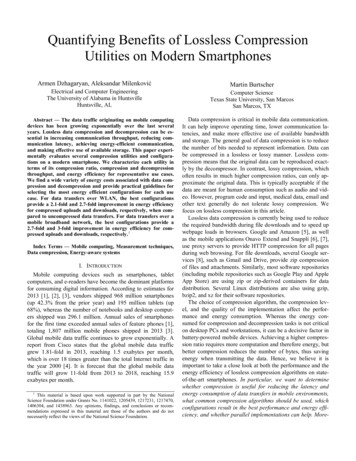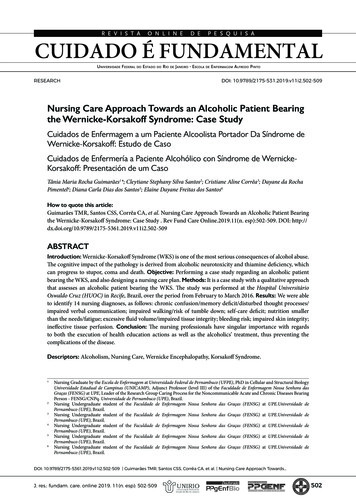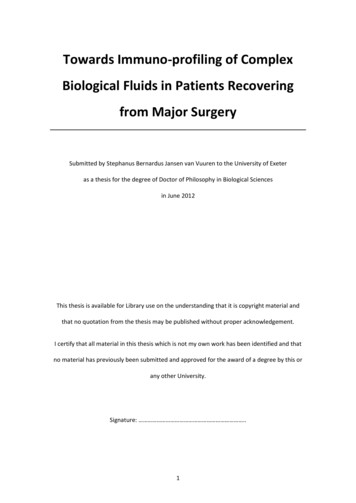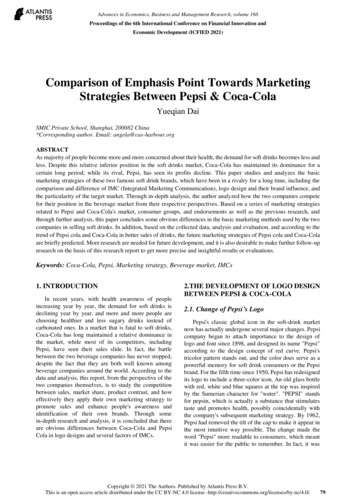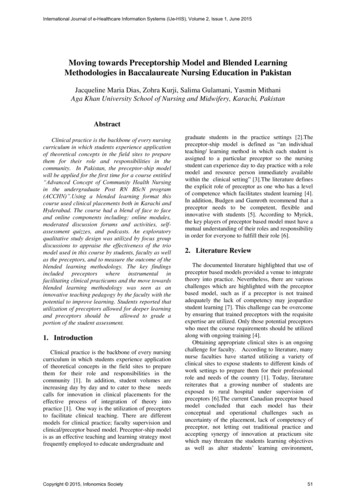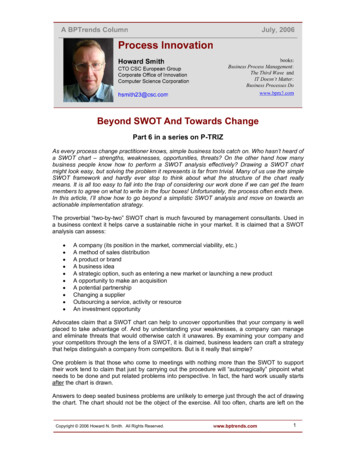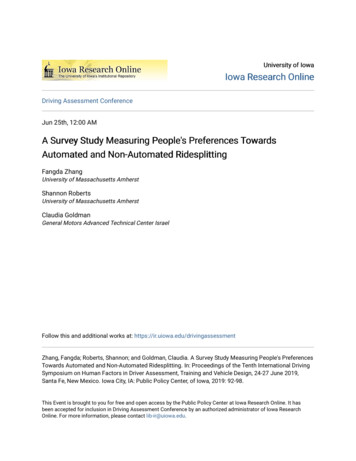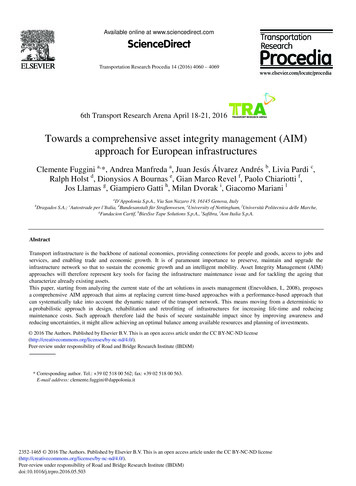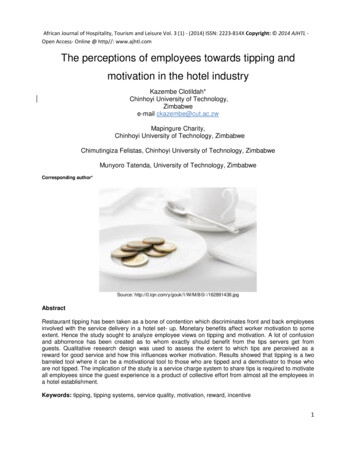
Transcription
Towards Models for Quantifying the Known AdversaryAlaadin AddasJulie ThorpeAmirali Salehi-AbariOntario Tech Universityalaadin.addas@uoit.caOntario Tech Universityjulie.thorpe@uoit.caOntario Tech Universityabari@uoit.caABSTRACTThe known adversary threat model has drawn growing attention ofthe security community. The known adversary is any individualwith elevated first-hand knowledge of a potential victim and/orelevated access to a potential victim’s devices. However, little attention is given on how to carefully recruit paired participants for userstudies, who are qualified as legitimate known adversaries. Also,there is no formal framework for detecting and quantifying theknown adversary. We develop three models, inspired by Social Psychology literature, to quantify the known adversary in paired userstudies, and test them using a case study. Our results indicate thatour proposed adapted-relationship closeness inventory and knownadversary inventory models could accurately quantify and predictthe known adversary. We subsequently discuss how social networkanalysis and artificial intelligence can automatically quantify theknown adversary using publicly available data. We further discusshow these technologies can help the development of privacy assistants, which can automatically mitigate the risk of sharing sensitiveinformation with potential known adversaries.CCS CONCEPTS Security and privacy Social aspects of security and privacy;KEYWORDSknown adversary, insider threat, social psychology, autobiographical authentication, social closenessACM Reference Format:Alaadin Addas, Julie Thorpe, and Amirali Salehi-Abari. 2019. Towards Models for Quantifying the Known Adversary. In Proceedings of 2019 New Security Paradigms Workshop (NSPW’19). ACM, New York, NY, USA, 15 ODUCTIONAuthentication schemes are often tested under several differentthreat models for security assessment before wide-scale industryuse. Recently, a special class of threat models, dubbed the knownadversary threat, has called the attention of the security community[3, 21, 22, 29]. The known adversary is any individual with elevatedfirst-hand knowledge of a potential victim and/or elevated access toPermission to make digital or hard copies of all or part of this work for personal orclassroom use is granted without fee provided that copies are not made or distributedfor profit or commercial advantage and that copies bear this notice and the full citationon the first page. Copyrights for components of this work owned by others than ACMmust be honored. Abstracting with credit is permitted. To copy otherwise, or republish,to post on servers or to redistribute to lists, requires prior specific permission and/or afee. Request permissions from permissions@acm.org.NSPW’19, September 23–26, 2019, San Carlos, Costa Rica 2019 Association for Computing Machinery.ACM ISBN 978-1-4503-7647-1. . . 15.00https://doi.org/10.1145/nnnnnnn.nnnnnnna potential victim’s devices, that uses these privileges with maliciousintent. The known adversary threat also accounts for the risk ofunauthorized access to devices/accounts by social insiders [29].1Known adversaries often have physical access to the devices/firsthand knowledge of a potential victim, which gives them an advantage, enabling them to access accounts/devices without permission.These intrusions can be a major privacy breach to potential victims,and can cause social and financial harm (e.g., accessing a bank account and transferring funds without permission). As a result, afew authentication schemes have been tested for resilience to theknown adversary threat [3, 17, 21, 22, 33].A common practice for examining the resilience of authentication systems to the known adversary threat is to recruit studyparticipants in pairs, who try to authenticate as each other [3, 21, 22].The participating pairs are asked to self-declare their relationshipstatus to each other (e.g., acquaintance, close friend, or spouse).Participants are then sorted into categories (e.g., strong or weakadversaries) based on their own relationship declarations. It is important to classify adversaries as weak or strong in order to gaugehow knowledge of a potential victim can effect the security of anauthentication system.However, problems arise with this method of testing for theknown adversary threat because users don’t always have the mostaccurate reading of their social relationships. Another flaw withthis method of testing for the known adversary threat is that itonly considers certain social labels as strong adversaries (e.g., coworkers would be classified as weak acquaintances, unless indicatedotherwise). Co-workers can have physical access to our devices,and due to their proximity or access to employee records, theymight have elevated knowledge of a potential victim that can aidin bypassing security measures.We propose a new process for testing the resilience of authentication systems to the known adversary. Our new process involves theutilization of questionnaires that paired participants must fill out atthe beginning of a user study (in lieu of simply self-declaring theirrelationship status). We propose three models to achieve this: (i)the adapted-Relationship Closeness Inventory (RCI); (ii) the KnownAdversary Inventory (KAI); and (iii) the Oneness Score. Each ofthese models has roots in the field of Social Psychology’s methodsto measure relationship closeness. We adapt these models to suitour need for a questionnaire that will assist researchers in quantifying the threat posed by the known adversary in a security/usabilitystudy.We test the viability of our models for quantifying the knownadversary through a case study. In our case study, participants were1 Onecan view the known adversary a more general form of unauthorized accessby social insiders as it encompasses a wider variety of threat sources including onesthat do not originate from socially close individuals. We also not that our knownadversary definition is not necessarily covered insider threat commonly used in thefield of business management; where it refers to the internal threat of employees tothe organization [34].
NSPW’19, September 23–26, 2019, San Carlos, Costa Ricarecruited in pairs to test the resilience of a proposed authenticationsystem to the known adversary threat. Instead of simply askingthe participating pairs to self-declare their relationship status, weasked the participants to answer questionnaires composed of theadapted-RCI, KAI, and Oneness Score. Our results indicate thatthe adapted-RCI and KAI are far better quantifiers of the knownadversary than simple relationship self-declaration. The OnenessScore failed to yield any substantive results in quantifying theknown adversary.The adapted-RCI, and the KAI, are valuable tools for assessingthe resilience of an authentication system to the known adversarythreat. However, this is a starting point for the development of amore rigorous and automated framework for detecting and quantifying the known adversary. While the questionnaires take less than5 minutes to fill out, that is still considered a cognitive burden, andthe validity of the answers provided in the questionnaires can bequestioned due to social pressures and strategic adversaries.Future work in this field should emphasize automatically detecting known adversaries through social network analysis, usingmetrics proven through our case study (e.g., frequent physical proximity, social media access etc.). Utilizing an automated tool fordetection serves two purposes: (i) ensuring that the known adversary detection and measurement is not based on answers that maybe influenced by social constraints (e.g., partners are pressuredinto answering that they are socially close), and (ii) decreasing thecognitive burden on participants in user studies to avoid fatigue.We envision utilizing social network analysis tools to automaticallyidentify potential known adversaries, and identifying the extent towhich a node in a social network is a potent known adversary. Thiscan aid in the development of fine-grained privacy assistants thatset targeted information sharing policies based on the potential fora security breach. For example, if a social acquaintance has beenidentified as a potentially potent known adversary, then we can stopthe information flow towards that social acquaintance (limiting theviewer not the content). This is an interesting point of discussionbecause the extent to which we limit sharing can undermine thepurpose of publicly sharing information on social media.2RELATED WORKAuthentication systems that have the potential to be compromisedby first-hand or publicly available knowledge (e.g., from socialmedia) of a potential victim are typically studied using paired adversary user studies or modelling [17, 21, 22, 22, 33]. In addition toautobiographical authentication systems, challenge questions aretypically vulnerable to this type of attack and tested by a pairedadversary user study [33]. In some research, participants are notalways recruited in pairs but some models are used to simulateadversarial guessing [17, 24]. We briefly review of some of thisresearch below.Muslukhov et al. [29], investigates the prevalence of breaches byinsiders, through the use of an online survey (n 724). They foundthat participants tended to be victims of insiders accessing theirdevices/accounts, with 12% of participants indicating that they wereaware of an instance of unauthorized access by an insider, and 9%of participants admitting that they gained unauthorized access toa device/account. We propose an expansion of the definition ofAddas et al.the insider, to include adversaries that are not necessarily sociallyclose to a potential victim, but are within physical proximity (e.g.,co-workers). Hence, we define an insider as any individual withelevated first hand knowledge of a potential victim and/or elevatedaccess to a potential victim’s devices, that uses these privileges withmalicious intent. We also refer to the insider threat as the knownadversary threat, to avoid confusion with the common utilizationof the term in the field of business management; where it refers tothe internal threat of employees to the organization [34].Hang et al. [22] studies the security of a location-based geographical authentication system by recruiting paired participantsand testing against the known adversary threat model under threeclasses of self-declared adversaries: (i) socially close adversarieswith no access to the internet; (ii) socially close adversaries withaccess to the internet; and (iii) stranger adversaries with access tothe internet. The authentication system was resilient, and no adversaries were able to guess a single location. Out of 15 participants(some of which acted both as an adversary and as main participant),4 relationships did not match (e.g., one participant described thepair as a good/best friend while the pair described the participantas a acquaintance/good friend).Hang et al. [21] performed a user study on another authentication scheme that relies on autobiographical data (e.g., incoming/outgoing calls) and tested the systems’ resilience to the knownadversary threat. In the user study (n 11), the participants wereasked to bring along two adversaries; one close adversary, and oneacquainted adversary. In this user study no contradictions in theself-declared relationships were observed. Generally, the close adversaries were far better at guessing authentication credentials thanacquainted adversaries.Albayram et al. [3] also performed a user study on an authentication scheme that relies on autobiographical data from everydayactivities. To test the authentication system against the knownadversary threat model, the researchers recruited participants inpairs (n 12 pairs). The participants were asked to self-declare theirrelationship status on a five-point Likert scale. No discrepanciesin the self-reported relationship characterizations were reported.However, participants were asked to bring along socially close individuals (e.g., spouse, or close friend), 4 pairs in the study werespouses/significant others and 8 pairs were close friends. The researchers modelled the weak (naive) adversary by randomly pairing.Generally, the strong adversaries performed much better at guessing authentication credentials than weak adversaries in this work.The general trend in this related work is that there is a reliance onself-declaring relationship status. However, there is no frameworkto determine if the recruited participants were a good sample ofknown adversaries. Our proposed models, in this paper, can benefitfuture research with paired adversarial models. Using our models,one can identify relationship characteristics (e.g., constant physicalpresence) of pairs rather than relying on a broad relationship label.Researchers using our models can know more precisely what socialfactors result in a high adversarial capability.It is important to note that our definition of the known adversarydoes not supersede more established variants of the definitionsof the insider threat [10–12, 14]. Previous attempts at formallydefining the insider threat have focused on the insider threat toorganizations, our definition of the known adversary is more broad
Towards Models for Quantifying the Known Adversarywith a focus on social insiders. Organizations typically have securitypolicies and defined physical perimeters, therefore an insider can bedefined based on the breach of a security policy or a defined physicalperimeter. However, individual users do not have a security policy,therefore it is difficult to define the insider threat to individualsbased on the breach of a security policy.Brackney and Anderson [14] define an insider as any individualwith privilege, access, or knowledge of information systems andservices [14]. Bishop [11] takes a different approach to the definitionof the ins
the adapted-Relationship Closeness Inventory (RCI); (ii) the Known Adversary Inventory (KAI); and (iii) the Oneness Score. Each of these models has roots in the field of Social Psychology’s methods to measure relationship closeness. We adapt these models to suit our need for a questionnaire that will assist researchers in quantify- ing the threat posed by the known adversary in a security .
